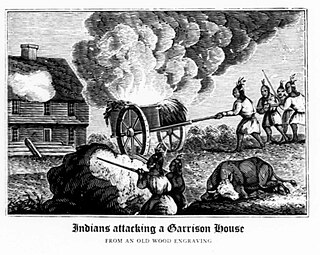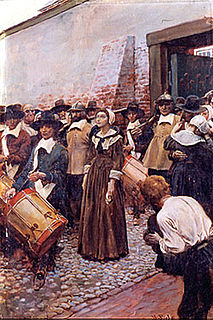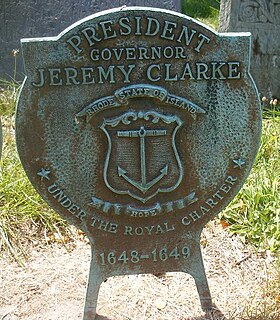See also
- Ralph of Coggeshall, English chronicler
Coggeshall is a small market town in Essex, England.
Coggeshall may also refer to:

Bristol is a town in Bristol County, Rhode Island, US as well as the historic county seat. The town is built on the traditional territories of the Pokanoket Wampanoag. It is a deep-water seaport named after Bristol, England.

King Philip's War was an armed conflict in 1675–1678 between indigenous inhabitants of New England and New England colonists and their indigenous allies. The war is named for Metacom, the Wampanoag chief who adopted the name Philip because of the friendly relations between his father Massasoit and the Mayflower Pilgrims. The war continued in the most northern reaches of New England until the signing of the Treaty of Casco Bay in April 1678.

Aquidneck Island is an island in Narragansett Bay in the state of Rhode Island. The total land area is 97.9 km2 (37.8 sq mi), which makes it the largest island in the bay. The 2000 United States Census reported its population as 60,870.

John Clarke was a physician, Baptist minister, co-founder of the Colony of Rhode Island and Providence Plantations, author of its influential charter, and a leading advocate of religious freedom in America.

Coggeshall is a small town of 4,727 residents in Essex, England, between Colchester and Braintree on the Roman road of Stane Street, and intersected by the River Blackwater. It is known for its almost 300 listed buildings and formerly extensive antique trade. Many local businesses, such as the White Hart Hotel and the Chapel Inn, have been established for hundreds of years. A market has been run every week on Market Hill since 1256, when a charter to do so was granted by Henry III.

Mary Dyer was an English and colonial American Puritan turned Quaker who was hanged in Boston, Massachusetts Bay Colony, for repeatedly defying a Puritan law banning Quakers from the colony. She is one of the four executed Quakers known as the Boston martyrs.

William Coddington was an early magistrate of the Massachusetts Bay Colony and later of the Colony of Rhode Island and Providence Plantations. He served as the judge of Portsmouth and Newport, governor of Portsmouth and Newport, deputy governor of the four-town colony, and then governor of the entire colony. Coddington was born and raised in Lincolnshire, England. He accompanied the Winthrop Fleet on its voyage to New England in 1630, becoming an early leader in Boston. There he built the first brick house and became heavily involved in the local government as an assistant magistrate, treasurer, and deputy.

The Portsmouth Compact was a document signed on March 7, 1638 that established the settlement of Portsmouth, which is now a town in the state of Rhode Island. It was the first document in American history that severed both political and religious ties with England.

John Coggeshall Sr. was one of the founders of the Colony of Rhode Island and Providence Plantations and the first President of all four towns in the Colony. He was a successful silk merchant in Essex, England, but he emigrated to the Massachusetts Bay Colony in 1632 and quickly assumed a number of roles in the colonial government. In the mid-1630s, he became a supporter of dissident minister John Wheelwright and of Anne Hutchinson. Hutchinson was tried as a heretic in 1637, and Coggeshall was one of three deputies who voted for her acquittal. She was banished from the colony in 1638, and the three deputies who voted for her acquittal were also compelled to leave. Before leaving Boston, Coggeshall and many other Hutchinson supporters signed the Portsmouth Compact in March 1638 agreeing to form a government based on the individual consent of the inhabitants. They then established the settlement of Portsmouth on Aquidneck Island, one of the four towns comprising the Colony of Rhode Island and Providence Plantations.
Nicholas Easton (c.1593–1675) was an early colonial President and Governor of Rhode Island. Born in Hampshire, England, he lived in the towns of Lymington and Romsey before immigrating to New England with his two sons in 1634. Once in the New World, he lived in the Massachusetts Bay Colony towns of Ipswich, Newbury, and Hampton. Easton supported the dissident ministers John Wheelwright and Anne Hutchinson during the Antinomian Controversy, and was disarmed in 1637, and then banished from the Massachusetts colony the following year. Along with many other Hutchinson supporters, he settled in Portsmouth on Aquidneck Island, later a part of the Colony of Rhode Island and Providence Plantations. He was in Portsmouth for about a year when he and eight others signed an agreement to create a plantation elsewhere on the island, establishing the town of Newport.
John Sanford was an early settler of Boston, Massachusetts, an original settler of Portsmouth, Rhode Island, and a governor of the combined towns of Portsmouth and Newport in the Rhode Island colony, dying in office after serving for less than a full term. He had some military experience in England, and also was an employee of Massachusetts magistrate John Winthrop's household prior to sailing to New England in 1631 with Winthrop's wife and oldest son. He lived in Boston for six years and was the cannoneer there.

John Easton (1624–1705) was a political leader in the Colony of Rhode Island and Providence Plantations, devoting decades to public service before eventually becoming governor of the colony. Born in Hampshire, England, he sailed to New England with his widowed father and older brother, settling in Ipswich and Newbury in the Massachusetts Bay Colony. As a supporter of the dissident ministers John Wheelwright and Anne Hutchinson during the Antinomian Controversy, his father was exiled, and settled in Portsmouth on Aquidneck Island with many other Hutchinson supporters. Here there was discord among the leaders of the settlement, and his father followed William Coddington to the south end of the island where they established the town of Newport. The younger Easton remained in Newport the remainder of his life, where he became involved in civil affairs before the age of 30.

Mary Holden Coggeshall Seward, commonly known as Mary C. Seward, was an American poet, composer, and prominent parliamentarian serving humanitarian and woman's club movements of the late nineteenth and early twentieth centuries. A number of her works were published under the pseudonym "Agnes Burney" , including several developed in collaboration with her spouse, Theodore F. Seward, an internationally known composer and music educator in his day. She became a groundbreaking advocate for the care and education of blind babies and young children during her later years, serving as president of the department for the blind of the International Sunshine Society.

Jeremy Clarke (1605–1652) was an early colonial settler and President of the Colony of Rhode Island and Providence Plantations. Born into a prominent family in England, he was a merchant who came to New England with his wife, Frances Latham, and four stepchildren, settling first at Portsmouth in 1638, but the following year joining William Coddington and others in establishing the town of Newport. Here he held a variety of civic positions until 1648 when Coddington's election as President of the colony was disputed, and Clarke was chosen to serve in that office instead. He was the father of Walter Clarke, another colonial governor of Rhode Island, and also had family connections with several other future governors of the colony.
Henry Bull (1610–1694) was an early colonial Governor of Rhode Island, serving for two separate terms, one before and one after the tenure of Edmund Andros under the Dominion of New England. Sailing from England as a young man, Bull first settled in Roxbury in the Massachusetts Bay Colony, but soon became a follower of the dissident ministers John Wheelwright and Anne Hutchinson, and was excommunicated from the Roxbury church. With many other followers of Hutchinson, he signed the Portsmouth Compact, and settled on Aquidneck Island in the Narragansett Bay. Within a year of arriving there, he and others followed William Coddington to the south end of the island where they established the town of Newport.
John Coggeshall Jr. was a deputy governor of the Colony of Rhode Island and Providence Plantations. The son of Rhode Island President John Coggeshall Sr., he was raised in the village of Castle Hedingham in northeastern Essex where his father was a merchant. Aged about eight, he sailed from England with his parents and surviving siblings, arriving in New England in 1632. He was first active in civil affairs in 1653 when he became treasurer of the island towns of Portsmouth and Newport. The following year brought the re-unification of the colony, with the island towns rejoining the government with Providence and Warwick, and he served as treasurer of the four towns for a year. His name appears on a list of Newport freemen in 1655, and for the following 35 years he served almost continuously in one or multiple roles including Assistant, General Treasurer, Deputy, General Recorder, and Major for the Island. He was one of ten Assistants named in the Royal Charter of 1663, which would become the basis for Rhode Island's government for nearly two centuries. In 1686 he became the Deputy Governor under Governor Walter Clarke, but his term lasted only a month when the English crown assigned Edmund Andros to be Governor of all the New England colonies under the Dominion of New England. Following the demise of this dominion and the arrest of Andros in 1689, Coggeshall was once again selected as Deputy Governor for the year ending in May 1690, serving under Governor Henry Bull. In April 1676, during King Philip's War, he was on a committee to procure boats for the colony's defense. Later that year, in August, he was a member of a court martial for the trial of several Indians.
William Dyer was an early settler of the Colony of Rhode Island and Providence Plantations, a founding settler of both Portsmouth and Newport, and Rhode Island's first Attorney General. He is best known for being the husband of the Quaker martyr, Mary Dyer, who was executed for her Quaker activism. Sailing from England as a young man with his wife, Dyer first settled in Boston in the Massachusetts Bay Colony, but like many members of the Boston church became a supporter of the dissident ministers John Wheelwright and Anne Hutchinson during the Antinomian Controversy, and signed a petition in support of Wheelwright. For doing this, he was disenfranchised and disarmed, and with many other supporters of Hutchinson, he signed the Portsmouth Compact, and settled on Aquidneck Island in the Narragansett Bay. Within a year of arriving there, he and others followed William Coddington to the south end of the island where they established the town of Newport.
Frances Latham, was a colonial American woman who settled in Rhode Island, and is known as "the Mother of Governors." Having been widowed twice, she had three husbands, and became the ancestor of at least ten governors and three deputy/lieutenant governors, and is related by marriage to an additional six governors and one deputy governor.